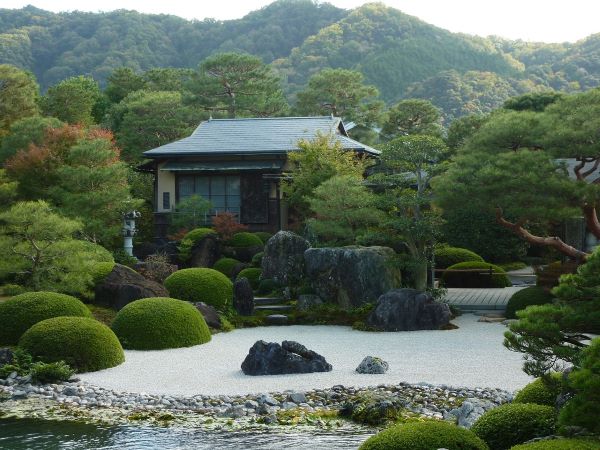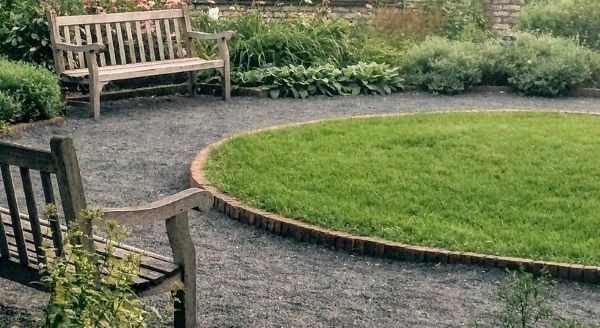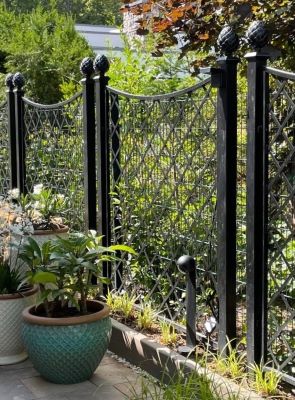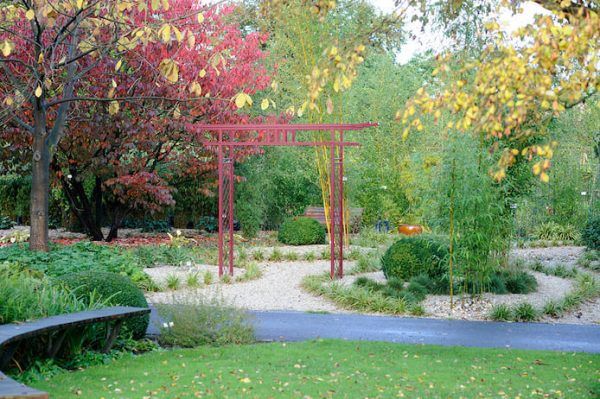- Simplicity (Kanso): At the heart of Japanese garden design lies the principle of simplicity.
Kanso encourages a minimalist approach, eliminating excess and focusing on
essential elements. Each element within the garden serves a purpose and
contributes to the overall harmony. Uncluttered spaces and clean lines create a
sense of calm and tranquility, allowing visitors to find solace in the
unadorned beauty of the landscape.
- Keep your plant list small.
- Choose mostly green plants with interesting textures.
- Keep hardscaping materials one color or with similar tones.
- Naturalness (Shizen): Japanese gardens aim to mimic the natural world, seamlessly integrating
human-crafted elements with the existing landscape. Shizen embraces the idea
that nature is the ultimate source of inspiration, and design choices should be
guided by its organic patterns and shapes. Emulating natural landscapes through
the use of rocks, water features, and plant arrangements fosters a sense of
authenticity and connectivity with the environment.
- Make plantings natural within—grouping plants rather than placing them in straight rows, except for hedging the outside of the garden.
- Use natural materials for hardscaping and pots in neutral colors. Choose planters and statuary with an organic look and texture rather than ornate designs. Cast stone and fiberstone are ideal.
- Asymmetry (Fukinsei): Unlike Western garden designs that often strive for symmetry, Japanese
gardens celebrate asymmetry. Fukinsei acknowledges the beauty in imperfection
and the dynamic balance that comes from irregularity. By intentionally
arranging elements off-center, the garden exudes a sense of movement and
spontaneity, inviting contemplation and a sense of wonder.
- While maintaining an overall balance, refrain from making opposite sides of the garden mirror images
- Place a small pond, fountain, or bird bath off to one side, rather than directly in the center.
- Make a zig-zag path, perhaps out of wide wooden boards arranged with only corners touching. It is said that evil can only follow a straight line, so the zig-zag pathway fools the evil spirits.
- Balance (Koko):
While embracing asymmetry, Japanese garden design seeks to achieve balance in
its composition. Koko involves the careful distribution of visual weight and
harmonious arrangement of elements. By skillfully combining heavy and light
elements, tall and short plants, or contrasting textures, a sense of
equilibrium is established, creating a serene and visually pleasing
environment.
- This is an important consideration in almost any garden design and is essential in shade gardens that will be heavy on foliage.
- Small decorative trees will add height and character.
- Where a tree is unsuitable, a simple obelisk or trellis can draw the eye up, adding interest to a flat, one-level garden.
- Placing a pot on a pedestal is another way to add multi-level interest.
- Plant wispy grasses or airy foliaged plants next to rugged stones or in heavy solid containers to emphasize the contrast.
- Empty Space (Ma):
This concept is integral to Kare Sansui design. It refers to the intentional
placement of empty areas within the garden, providing visual breathing space
and allowing the viewer to appreciate the arrangement of rocks and patterns
more fully. Empty space encourages contemplation and fosters a sense of
peacefulness.
- Don’t fill every nook and cranny. Leave an open area, perhaps in the center of the garden, as a space to reflect and view the remainder of the garden.
- Place empty planters among grouping of filled ones, or partially bury one on its side—broken planters are great for this. An empty planter can have just as much impact or more than a planted one, with the added benefit of zero maintenance.
- An “empty space” calms the mind by bringing order to the cultivated chaos of a typical colorful perennial garden. The open area highlights the surrounding garden as the eye will more easily focus with less distraction.
- In a modern garden, this might be an open circular grassy or mossy area edged with a few curved benches, with or without a small statue or water feature in the center depending on the size of the area.
- The empty space might also be a place for family and friends to gather, softly illuminated by lanterns and a firepit in the evening. Place permanent furnishings around the edges only or choose stackable items that can be easily stored when not in use.
- Symbolism (Yugen): Japanese gardens often incorporate symbolism, imparting deeper meanings
and philosophical reflections. Yugen refers to the suggestion of profound,
indirect, and mysterious beauty that invites contemplation. Water, for
instance, may symbolize life's continuous flow and renewal, while rocks might
represent stability and permanence. These symbolic elements encourage visitors
to reflect on the interconnectedness of all living things.
- If you feel personally connected to a thing or place, include a reminder of that in your garden, such as a rock or piece of driftwood brought back from a special vacation spot.
- Set a statue of your spirit animal or one representing your faith in a prominent place.
- Natural elements strike chords with many of us. “Fire” people might include a fire pit, “water” people a fountain or pond. Other symbols of nature, such as the earth, sun, moon, and trees or birds might resonate with others.
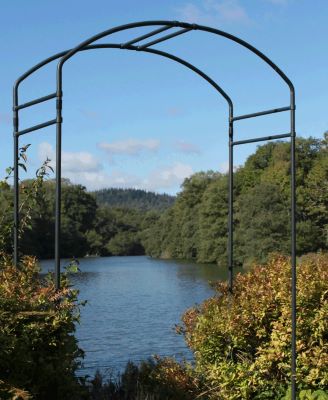
- Borrowed Scenery (Shakkei): Borrowed scenery is a unique concept that integrates the
surrounding landscape into the garden's design. By framing distant natural
features such as mountains, trees, or bodies of water, the garden extends
beyond its physical boundaries, creating a sense of vastness and enhancing the
overall ambience. This technique allows the garden to be in harmony with its
larger environment, blurring the line between the cultivated and the wild.
- Use a simple arch to frame a distant view. Place obelisks at alternating points down a pathway to draw the eye toward an engaging scene.
- If you have picture windows or sliding glass doors, consider those a frame to the view outside and refrain from blocking an attractive vista with large shrubs or tall fencing. Taller plantings to either side of the windows with shorter plantings farther back will help create depth and perspective in a smaller garden.
- Enclosure (Engawa): Enclosure, or Engawa, is a principle that defines the boundaries of a
Japanese garden. Traditional Japanese gardens are often enclosed by bamboo
fences, walls, or hedges. This sense of enclosure offers a feeling of intimacy
and separation from the outside world, fostering a sense of serenity and
detachment from everyday distractions.
Enclose a smaller area of the garden with low fencing or shrubbery.
- Emphasize the opening into the main or inner garden with an arch or arbor.
- Create a peaceful nook with a vine-covered gazebo, pergola, or bower.
- Add privacy with a screen or trellis.
In our fast-paced and technology driven world, many of us long for a respite from the stress and anxiety of our daily lives. A peaceful garden is where some of us turn to reconnect with the natural world and rejuvenate our spirit. What could be better than finding that tranquil spot in your own backyard?
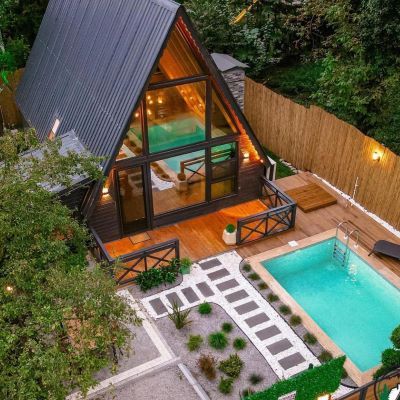
For the ultimate in serenity, consider the Japanese garden, initially created as a sacred space for contemplation and meditation. An ideal garden for modern minimalist and mid-century modern architecture, the Japanese style can also blend beautifully with contemporary rustic and cottage or craftsman style homes. Various elements of these gardens can be artfully included in almost any design when a calm, relaxing space is desired.
Is a Japanese style garden right for you? We’ll help you decide by explaining the evolution and basic principles of Japanese garden styles. We’ll advise you on how to incorporate those ideas into your landscape, discuss the necessary requirements, and suggest the right plants, hardscaping, and décor features. Even if the complete aesthetic doesn’t work for you, you’re sure to find some elements that will bring harmony and contentment to your landscape.
Brief History of Japanese Garden Design
Japanese garden styles have evolved over the centuries. The first Japanese gardens borrowed much from Chinese feng shui principles, and were influenced by the ancient Shinto religion, which regarded natural elements as sacred. These were pleasure gardens, with visitors often enjoying the scene from boats in the many garden ponds and lakes.

Centuries later, gardening practices changed due to the influences of Zen Buddhism and the rise of the military. Instead of focusing on pleasure, austerity and meditation became the key concepts in Japanese garden design. Kare Sansui, or the Dry Garden, was the main style during this time, centering on the harmonious arrangement of rocks, gravel, and raked sand, with the occasional green shrub.
With the development of the tea ceremony came Chaniwa, or the Tea Garden. This created a private yet welcoming space with its inner and outer garden concept. The secluded inner garden was at least partially covered by the tree canopy, beneath which the plantings were softer and less rigid. Cleanly trimmed hedges and bamboo fencing marked the transition between this more rustic, natural garden and a formal outer garden. Stepping stones, lanterns, and water basins were important features.
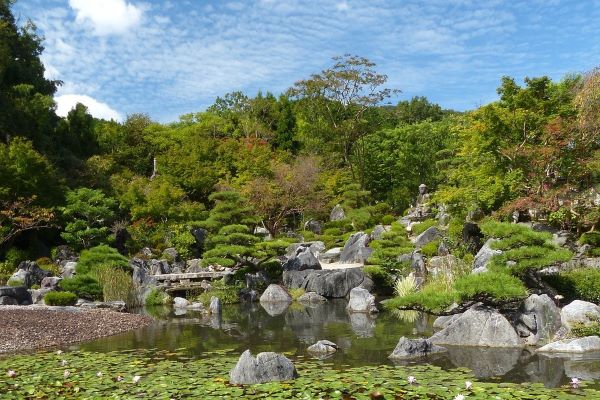
As the years passed, the ruling classes once again created gardens for enjoyment and recreation. Tsukiyama, which interprets literally as “artificial hill,” involves the creation of varying elevations with grading, rock formations, and plantings to mimic the larger natural landscape. The large mounds and hills that were created by digging the extensive ponds popular in early Japanese gardens became popular again hundreds of years later as part of “strolling gardens.” Visitors are repeatedly rewarded with enchanting views that magically appear as they follow the winding pathways. Trees, shrubbery, rocks, streams, and ponds combine to create a masterful interpretation of a larger landscape in a smaller space.
Basic Principles of Japanese Garden Design
- Change over Time (Shi Zen Bi) and Imperfection and Impermanence
(Wabi-Sabi): Japanese gardens embrace the concept of change
over time, acknowledging the impermanence and transience of all things. This
principle encourages gardeners to embrace the natural aging and transformation
of elements such as moss, rocks, and plants. The evolving nature of the garden
symbolizes the cyclical nature of life and adds a layer of depth to its beauty.
- Allow moss to grow on pots and statuary. Using porous materials like concrete and clay pots in damp shade will encourage mossy growth.
- Edgings do not need to be perfect. Plant ground covers that will flow gently into pathways.
- Rock walls can be enhanced with weeping or creeping evergreen plants that spill over the edge.
- Allow plants to age naturally to bring out their distinct characteristics, instead of pruning to a perfect shape. Many conifers and broadleaf evergreens will develop a more interesting open habit with time and judicial pruning, akin to a large bonsai. This means careful consideration for the mature size of the plant to prevent having to continually prune for size.
- Choose minimalistic décor in materials that will naturally weather or patina, such as stone, wood or copper.
- Again, broken planters can make a fascinating accent, so think twice before tossing. Planter pieces could gently cradle a mound of soft moss or dwarf mondo grass.
- Focal Points (Meoto Tei): A Japanese garden often features carefully selected focal
points or central elements that draw the eye and create a sense of harmony
within the landscape. These focal points can include a stone lantern, a water
basin, stone sphere, or a unique rock formation. The strategic placement of these
elements encourages contemplation and a sense of journey through the garden.
- In a large garden, pathways can lead to various focal points throughout the garden.
- Kare Sansui gardens were often designed to be viewed from one specific perspective. Choose the area or areas your garden should be viewed from—the patio, an upper floor window, from the inner garden looking out, etc. Create focal points appropriate for each view you wish to highlight.
- Don’t overdo the accents. Keep it simple and remember to allow for “empty space” to better focus on your main objective.
- Seasonal Variations (Kisetsu): Japanese gardens celebrate the beauty of each season, with
design elements and plant selections that change with the passing of time. From
the delicate cherry blossoms in spring to the vibrant maple leaves in autumn,
these seasonal variations provide visitors with a continually evolving
experience, encouraging frequent visits and a deeper appreciation of nature's
cyclical rhythm.
- Consider how your garden will look in each season and try to note changes in sunlight through the year that might affect your plant choices.
- Start with winter, as the combination of deciduous trees, evergreens, and hardscaping creates the “skeleton,” or framework upon which the remainder of the garden should be created. Remember to include visual interest at different levels rather than creating a flat landscape.
- Select further plants for spring, summer, and fall interest. In the Japanese garden style, this would usually be spring blooming shrubs and small trees, with foliage textures highlighted in summer followed by striking fall leaf color.
- Size: There are no size requirements; however, the
smaller the space the less features you will be able to incorporate.
- For very small courtyard gardens, Kare Sansui or Chaniwa inner garden practices would be more appropriate. One small decorative tree, and a few medium height evergreen shrubs set within waves of evergreen groundcover would suffice. Highlight with one or two accent pieces (stone sphere, lantern, or small water feature) and a gravel pathway. Alternatively, a gravel covered central space could be combined with teak benches and a rustic firepit, surrounded by beds of evergreen groundcover dotted with container gardens of various heights.
- Medium sized gardens could include a small pond hilled up on one side with a characterful shrub or small weeping tree upon it. A tiered wooden deck provides options for an interesting placement of planters or a small water garden. A carefully chosen large rock makes an excellent focal point, or even an organic seating area. Pathways can be made of large tree branch or trunk “slices” and stumps can become seats or hollowed out and planted.
- Large properties have the advantage of being able to include many different features of Japanese garden style. The front of the house might include simple low hedging, raised stone-walled planting beds, and layered plantings. This might lead to a tea garden under a large tree on the side of the house, and then through an archway to a stroll garden with multiple focal points including a pond with waterfall and a generously sized gathering area with benches and lanterns.
- Maintenance Considerations: Maintaining a Japanese style garden requires attention to
detail and regular upkeep to maintain beauty and balance. Consider the
following maintenance tasks:
- Weeding: Obviously, this is the biggest hurdle, but easily doable for smaller spaces. Especially when using Kare Sansui techniques with sand or gravel, be sure there is adequately thick and long-lasting landscape fabric beneath to suppress weeds. If enough organic material builds up in graveled areas weed seeds may still sprout. To prevent this, edge bed areas carefully with wood or stone an inch or so above the planting level to prevent run off into adjacent areas. Chemical products that keep seeds from germinating (Preen, for example) can be used if necessary. In large areas of groundcover you may want to incorporate stepping stones so you will be able to easily reach the interior of those areas for upkeep.
- Pruning and Trimming: Regularly trim plants to maintain their desired shape and size. Prune any dead or diseased branches to promote plant health. Remember that other than hedging used to enclose garden areas, pruning should be carried out in a fashion that enhances the natural growth habit of the plant. In contrast to the usual trimming to promote full, bushy growth shrubs would be thinned to reveal and emphasize interesting branch structure.
- Cleaning and Maintaining of Water Features: You will need to prevent algae growth and ensure proper water circulation in ponds and streams. Barley straw or UV light filters can greatly reduce or eliminate algae. Keeping 60 to 75% of the surface of the pond shaded will also help—adding floating plants like water hyacinths or water lettuce is an attractive solution. For container water gardens or large water basins that do not have circulation you should add Mosquito Dunks or similar product to prevent mosquitos breeding in the still water.
- Raking and Maintaining sand, gravel, or moss areas for cleanliness and aesthetic appeal.
- Regular Watering and Fertilizing: not much different than in any other type of garden; likely less, as conifers and many groundcovers tend to be drought tolerant once established.
- Seasonal Clean Up/Winter Prep: With many evergreens in the garden, there won’t be much cleanup required. Fountains and water basins that are not weatherproof will need to be drained and covered to prevent freeze damage.
- Define Your Needs: Before you create any garden, think about what you want to achieve and how you will use the space. Do you want a garden that you will mainly view from inside, or from a raised deck? Or would you prefer a “walking” garden with separate “rooms”? Do you need entertaining space? Do you need space to grow edibles? Do you need a play area for children? Do you want a separate cutting garden? If your landscape is primarily blank as with new construction, you can arrange it to suit your needs. Otherwise, you may need to reconstruct part of the landscape to add additional features. Always consider grading and drainage before making any large-scale changes.
- Selecting the Right Plants: In our next installment, we’ll tell you about the perfect groundcovers, perennials, shrubs, and trees to achieve a Japanese garden ambience. Most of these will have a variety of garden uses, including shade gardens, rock gardens, and foundation plantings, so check them out to see how you can enhance your own special garden spot.
Requirements for a Japanese Style Garden
Creating a Japanese style garden allows you to bring tranquility and timeless beauty into your outdoor space. By incorporating the principles of Japanese garden design you can craft a serene haven that promotes relaxation and harmony. Embark on this journey to experience the grace and tranquility of a Japanese style garden in your own backyard.


